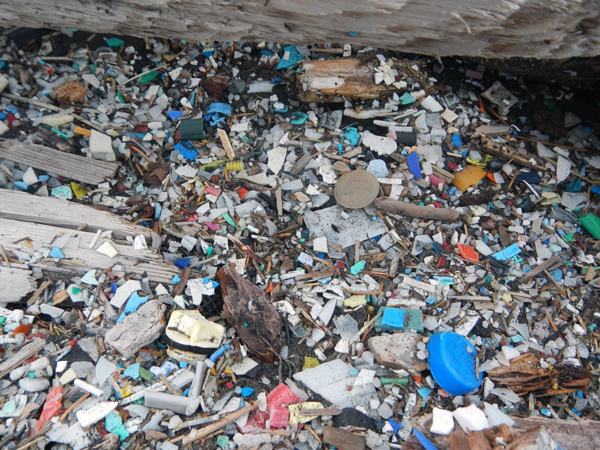
Thanks to funding from the government of Japan, plans are being made to pick up hundreds of tons of plastic marine debris that has been gathered from Alaska beaches.
Gulf of Alaska Keeper was already in the trash business, picking up old fishing gear, when the 2011 tsunami swept away miles of buildings, docks, vehicles, contents of dumps, tanks, and other materials along the coast of Japan and sent much of it floating across the Pacific. The organization knew where it was most likely to hit. And it did, says Keeper President Chris Pallister.
“A tremendous amount of trash,” Pallister said. “Some of our outer coastline beaches that are hard on the Gulf of Alaska have as much as 30 tons of plastic debris per mile, which is an astounding amount of plastic.”
Talk of Alaska: Plastics in the Ocean
The resources to respond were nowhere near adequate, but concern about the debris was widespread, particularly in villages along the coast, which often organized their own cleanup efforts. A number of organizations got involved, including the cruise ship industry. There was a small helping of federal funds – $50,000 per state, but then the Japanese government sent $5 million to help with the cleanup. Part of that money was released to Alaska through the National Oceanic and Atmospheric Administration last year. Gulf of Alaska Keeper was able to bring more cleanup workers to some of the shores. It wasn’t easy:
“Every year we get our small skiffs and stuff flipped and you know it’s a challenge, and it costs a lot of money,” Pallister said. “We’re exposed out there in the Gulf with our small vessels, and it’s a very, very difficult, dangerous job for all of us.”
The plastic was gathered up, often placed in huge bags, but then it had nowhere to go. It was just left stacked up, waiting for whatever arrangements could be made to remove it.
This year another $900,000 has been released to Alaska from the Japanese donation, and Pallister plans to use it to engage a helicopter to lift the material, and a huge barge to take it to a destination that is still undetermined.
“Now that we have some money, we can do this. It’s not gonna be enough money to do everything we want to do. We hope to get down there and work with the Sitka Sound Science Center and all the folks down in southeast Alaska that are consolidating debris this summer,” Pallister said. “And hopefully this barge will just make a circuit around the northern Gulf, go down to southeast Alaska and we’re talking with our colleagues in British Columbia, they may join us too, and take a big load of trash down to a recycling center in Seattle.”
It’s going to have to be a pretty big barge, and it’s going to take another cleanup mobilization as well.
“We have 1,800 super sacks and a lot of other loose debris,” Pallister said. ”It’s probably about pretty close to 3,000 cubic yards of plastic, and we expect to double that by mid-July of this year.”
And it won’t be the end of the plastic trash. In recent years, Gulf of Alaska Keeper’s cleanups have been coming across a lot more than fishing gear on those exposed beaches. The way Chris Pallister sees it after 12 years of beach cleaning, the tsunami just added to an already existing – and growing – plastic debris problem on Alaska’s coasts.
“That basically doubled our volume, but we’ve always had a really bad problem up here, and it’s mostly western pacific drift that we’re gettin’ up here, it’s not local,” Pallister said.
The material that drifts and blows ashore during storms is just the most visible form. A lot more has broken down into small pieces that can be mistaken for food and ingested by birds and fish. Efforts to assess the impacts of those micro- and nano-plastics in the marine environment are just beginning.
